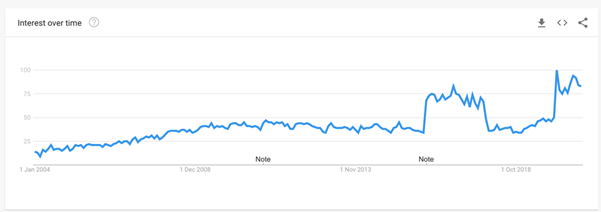The demands on SEO are growing every day
So are the opportunities in SEO.
Not only is the SEO discipline expanding, so is the size of the market, which is predicted to reach $1.6 billion by 2027.
SEO has developed over recent years from being a siloed practice to a significant revenue channel.
A channel that is becoming integrated into content marketing practices and overall digital strategies.

SEO is unique in its nature.
From shifting marketing conditions to changes from search engines and customer priorities, marketers always have to stay on top of many changes.
As a result, SEO methods are constantly evolving due to search engines’ developments and consumer behavior changes.
It is never easy to stay on top of the most successful optimization techniques.
And when done incorrectly, recovering can be difficult and even more time-consuming.
Below are some common SEO mistakes with tips on how to avoid them.
Mistake 1: Not Knowing Your Audience
One of the fundamental principles of SEO is to understand your target audience.
That means knowing your audience at the most minute and granular level.
SEO is the customer’s voice.
While many marketers think they know their audience, they often fall into the trap of not understanding how consumers behave in their market and then at a granular level.
At the same time, as consumers expect instant responses and results to their queries. They often want this in real-time.
While historical data still gives SEO great insights into seasonal trends, marketers’ methods to understand their customers have to be holistic.
One of the most common mistakes in selecting keywords is neglecting the preference of search engines and users for long-tail keywords.
While you might define your products and services in a certain way, it’s more important to understand what words your potential customers would use to refer to them.
Tips:
- Look to understand the market in which your consumers buy – what are the macro trends?
- Utilize both historical and real-time data to understand how behavior is changing.
- Map what you find about consumer intent to your keyword selections and strategy.
- Utilize Google keyword planning tools and vendor tools at your disposal.
Mistake 2: Not Having an SEO Plan & Roadmap
There is no point knowing all about your audience and then taking little or random action on maximizing opportunity from that knowledge.
Many organizations struggle to either build or execute on strategy from large enterprises to small and medium-sized businesses.
Last year only 36% of small businesses had an SEO strategy.
Building an SEO strategy and roadmap is critical for success.
However, many plans fail as building a sustainable and efficient strategy relies on multiple stakeholders – website, PR, content, product, IT, and engineering.
There is also the issue of ensuring that any strategy has executive buy-in and internally understand the importance of SEO, and are trained on SEO best practices.
If you don’t have a roadmap – a blueprint for your success – you need to build one now.
Look at where your site and results are now and where you want it to be.
Set goals and agree on workflows.
Tips:
As part of your plan:
- Evaluate and understand your competition – rankings, keywords, content, and performance.
- Break down actions in tasks and agree on goals and key stakeholders.
- Agree on roles for content, site updates, digital alignment, and SEO evangelism.
- Look for technologies – tools and platforms that will help with workflow and your strategy.
Mistake 3: Creating the Wrong Type of Content
Another common pitfall in SEO is producing content that is not actually about your audience.
The problem is that you want to rank for a particular keyword, but you fail to focus the text on your target topic.
Search engines like Google want to serve their users with the most relevant content for their search terms.
Thus, if your content does not answer user needs, it won’t rank well.
This mistake is often a result of:
- Trying to fit a few different topics within a single piece of content.
- Creating low-quality work just for the sake of including keywords.
- Optimizing for multiple keywords in one article.
Your primary goal should be to produce content that genuinely corresponds to the questions and needs of your target audience, including using the right search terms.
Then search engines will be able to trace your content as matching the keyword you are optimizing for.
Marketers can make two big mistakes with content:
- They are not focusing on content for the right audience.
- Not producing content that is based on expertise, authoritative, and is trustworthy.
Hence it’s vital to create content that Google wants.
Tips:
- Ensure content and SEO strategies are tightly aligned – per your SEO strategy and roadmap.
- Make sure your content answers the questions people are searching for.
- Create multiple types of content for different needs and SERP layouts – video, visuals, text.
- Follow Google’s best practices on search quality and E-A-T.
Mistake 4: Publishing Non-Original Content
Following on from the above, the next typical mistake is related to the quality of your content.
While duplicating text was a common practice back in the day, today, search engines penalize this approach.
Copying and plagiarizing content is seen as spammy practice and is highly discouraged.
Duplicate and thin content simply doesn’t work.
Instead of ripping off copy from other places or using software that “spins” the content into a new shape, it’s worth investing in creating original and meaningful content.
This is the only way to make sure your website doesn’t get downgraded and pushed to the back of search results.
Tips:
- Create strong headlines that match the topic your content is about. Don’t mislead readers.
- Ensure content provides answers and have actionable information. Give examples.
- Create stories that people can relate to and engage with. Quote trustworthy sources.
- Add videos and images to enhance the reader’s experience. Be creative.
Mistake 5: Skipping Title Tags & Meta Descriptions and Forgetting to Provide Context with Schema
Optimizing your content does not end once you include a target keyword in your articles.
Title tags and meta descriptions are essential elements of SEO that should not be forgotten.
Skipping them means a huge missed potential for your content.
These optimizing factors are considered by search engines when crawling your website so, if done correctly, they can improve your content’s performance.
Some marketers also forget to use schema to mark up their content and tell search engines what their site is about.
Creating content is great, but without this, search engines struggle to understand the context of your content.
It means you rank lower in typical searches and be less relevant in specific queries made through voice search.
Another technical detail that content marketers sometimes forget is including image tags.
The alt tags of the visuals you include in your content are essential, as they are another sign of how you are targeting articles.
Search bots cannot see the pictures – but they can read the alt tags and add this information in the way they index your pages.
Tips:
- Write unique title tags for each page that is brief but descriptive – not vague.
- Ensure you match your keyword to intent and be careful where you place it.
- Avoid title tags that are too long and make them unique across all pages.
- Follow Google’s best practices on creating good titles and snippets.
Mistake 6: Missing Quality Links
To get the best from SEO, content marketers today should grasp that the quality of external links included in content is more important than their quantity.
That’s why it’s better to make sure you link to relevant, well-ranking websites with solid reputations – not just any site.
It’s also useful to link back to sites that have linked to you, as this brings back traffic in the future.
Another counterproductive practice when it comes to links is using ineffective anchor text.
This wastes precious SEO opportunities, as anchor text signifies to the reader and search bots what the link is about and how it can be beneficial to users.
Thus, avoid using “click here” as an anchor text and make sure you opt for a variety of anchor texts, as employing the same text over and over again can be seen as spammy.
Tips:
- Build a link building program based on quality and best practices – don’t buy.
- Monitor and check for broken links and fix them.
- Build content that is based on E-A-T – quality content naturally attracts links.
- Use technologies and tools to help monitor and build.
Mistake 7: Going Astray with Your Internal Links
There are also common mistakes when including internal links that you should watch out for.
Naturally, it’s crucial to think about your top-performing pages and consider placing links to them in your content.
This is a way to give them visibility and create additional traction.
But make sure you don’t include internal links just for the sake of having them in an article if they don’t match the topic and focus of the piece.
As with keyword stuffing, it’s crucial to watch out and not overdo internal linking.
If the content and links seem unnatural, the work will not be appreciated by your target customers.
It would not be favorably treated by search engines either, as it can be seen as a fraudulent practice.
Tips:
- Group topically-related webpages with internal links.
- Audit internal links for issues – broken links, slow pages, important versus non-important pages.
- Balance the number of internal links you use.
- Avoid any linking from irrelevant pages.
Mistake 8: Not Investing in a Fast & Mobile-Friendly Experience
SEO is not only about content and keywords.
It’s also about your website’s quality, particularly its performance on mobile devices, which are users’ top choice today.
Google and other search engines can recognize when your website is not mobile-friendly, especially as Google looks at mobile-first indexing.
If you haven’t considered a smooth mobile experience for your audience, your rating on search engines can be jeopardized.
The same goes for load speed, as search engines put an emphasis on that as well.
You shouldn’t be surprised if a slow website leads to lower positions on the SERPs.
Organizations that make mobile SEO mistakes typically fall around:
- Slow site speeds.
- Block files.
- Slow to load images and videos.
- Interstitials ads.
- Poor local information.
- Non-responsive web design.
Tips:
- Improve your site’s loads time as a priority to avoid people bouncing.
- Ensure you have a responsive design to make it easy for users to browse your mobile site.
- Optimize and ensure local and mobile strategies align.
- Create mobile content aimed at giving users a better mobile experience.
Mistake 9: Not Understanding How SEO Works Across Digital Channels
SEO has a social and digital dimension.
As SEO has now become an integral part of digital marketing – and to maximize its potential – it’s essential not to make the mistake of overlooking how it works with other channels.
Not integrating your SEO with other marketing channels means you will miss out on measuring its full impact.
You and your company will struggle to elevate SEO success, internally and externally.
SEO requires support from several key marketing channels and, at the same time, has a positive effect on them all.
Building a symbiotic relationship and agreeing on goals and measures of success across channels – social, email, paid, and PR – is all part of modern-day SEO.
Tips:
- Ensure that your SEO strategies take account of inputs and outputs from all digital channels.
- Evangelize SEO success across your organization and show how it helps other channels.
- Keep in constant contact with digital counterparts – internally and externally.
- Ensure everyone in your wider digital team is bought into your SEO plan and roadmap.
Mistake 10: Not Utilizing Analytics & Using the Wrong Tools & Technology
The only way to know if your SEO and content efforts work is to track their progress.
Many marketers would disregard the numbers, but this is a severe mistake.
Setting up and regularly reviewing your analytics is essential for your optimization results.
Google has many tools such as Google Analytics and Google Search Console that you can use to measure and get an overview of your website’s performance.
With their help, you can see how your optimization works for the different kinds of content and uses various strategies you are trying out.
Furthermore, the SEO technology space has developed massively over the years.
There are several tools and platforms that can now help you avoid all of the mistakes listed in this article.
Solutions range from:
- Keyword research.
- SEO management and workflow.
- Link management, reporting, and measurement.
- Competitive analysis.
- Automation.
- And more.
Tips:
- Look for a tool or platform that best serves you and your organizational needs foremost.
- Tools can often help with certain parts of your SEO strategy – on tasks and are low cost.
- Platforms can cover many needs – mostly enterprise and are more expensive.
- Tools and platforms will help your increase efficiency and help you execute SEO strategy.
Summary
Search engine optimization is an indispensable part of any content marketing strategy today.
Even the best people can make many typical SEO mistakes.
It’s better to get well acquainted with the challenges others have experienced and avoid them in your marketing efforts.
These 10 errors have proven quite widespread, so they are now easier to recognize before you make them.
More Resources:
- 8 Silly But Harmful SEO Mistakes Even Professionals Make
- 11 Big SEO Challenges You’ll Face in Your Career
- SEO for Beginners: An Introduction to SEO Basics
Image Credits
All screenshot taken by author, October 2020





